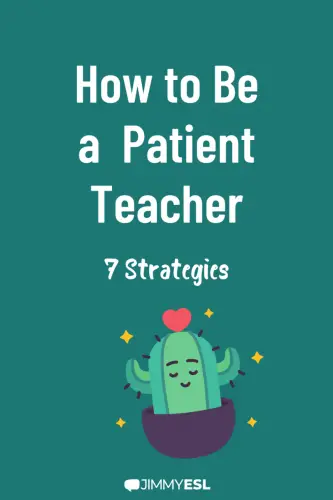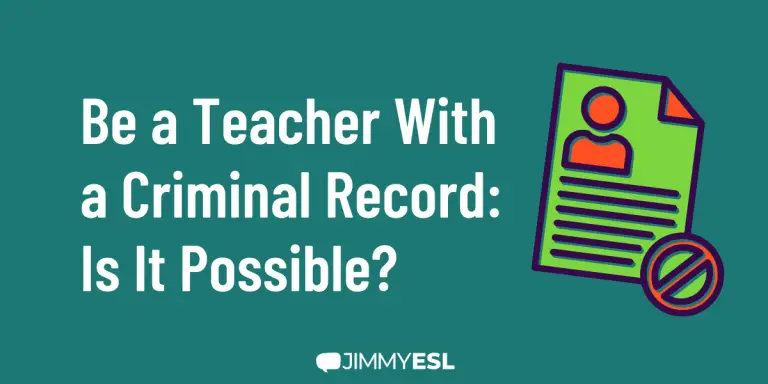How to Develop Patience as a Teacher? 7 Practical Strategies
We are discussing and trying out various teaching tools all the time but fail to remember the most powerful tool that teachers have: patience.
Pressured by the overwhelming day-to-day tasks and obligations, let alone disobedient students and demanding multitasking, did we lose this magic, yet almost endemic trait?
Personally, I usually find it hard to stay patient at work while living in a world where “fast” means “effective”.
Sometimes I remember that progress takes time, but often I feel impatient and frustrated when I see that some students are lagging behind despite my efforts.
So lately, I’ve implemented 7 techniques that helped me to develop my patience as a teacher and approach teaching from a different angle. Read on and try them yourself!

Why Is Patience Important In Teaching?
Patience in teaching means dedicating the necessary time and effort to help students learn something, with the intention to explain, contextualize and build on their prior knowledge.
Patience also refers to developing and maintaining trust in the student-teacher relationship.
Both the teacher and the student need to believe that their actions will eventually bear fruit, though they may face many obstacles on the way.
Despite the common misconception, being patient as a teacher doesn’t simply mean “waiting for students to become better”. In fact, using patience as a tool reflects in all aspects of your work: like being patient with peers and their requests but also with yourself when you’re approaching the end of a term, and you have a pile of stuff to get done.
Being patient when working with students requires higher emotional control and awareness on the side of the supportive teacher, allows learners to make mistakes but also encourages students to analyze them and create new solutions.
This, on the other hand, turns students into critical thinkers instead of marathon runners for the “best” results — a very pragmatic quality for their future.
In other words, neither teaching nor learning can be effective if there’s no patience which makes it fundamental in all educational processes.
The college science professor and educational expert Leslie Schwab highlights patience as the top trait of any effective educator, along with concern for students, knowledge of the subject being taught and willingness to adapt.
Schwab writes that patience is important as teachers cannot expect all students to progress at the same pace, so their task is to provide more extensive explanations in several times. According to her, the counter tactic, i.e., “go home and practice more” usually triggers anxiety and insecurity in students that would eventually reflect on the work of the teacher.
Nevertheless, we can’t just put a blind eye on the fact that teachers are only humans, and they can simply lose patience and snap. Some of us are triggered by the noise, others by the scratching of chairs on the floor, or by the constant “forgetting” of homework…
After all, research has shown that during their career, teachers have more stress and frustrations than workers in other fields, and show a bad temper.
On the surface, patience may seem complicated to master, yet there are many small steps that you can make to see it grow within you and resonate in your working place.
Also read: How to become a good and effective ESL teacher.
7 Strategies for Teachers to Be More Patient
Follow these strategies to develop patience and stay calm in stressful environments or situations.
1. Take Care of Yourself
Yes, this is my number one, top tip as there’s no way to stay calm, focused and productive at work without providing basic personal care for your physical and mental health.
Despite what mainstream culture of work preaches, burnouts are not a sign of professional success but of a low-quality life.
Going to the spa once a week or weekend getaways in Tuscany sound fantastic, but I’ll stick to simple self-care strategies that any teacher can try on a daily level:
Get enough sleep
Make sure you sleep enough hours every night. Believe me when I say that NOTHING can soothe your nervous system better than regular slots of quality sleep. Make it a priority.
Make routines and stick to them
I already wrote about establishing routines as great stress-relievers when it comes to task management and feeling calm on a daily level.
Wake up a bit earlier, start the day with a cup of coffee and NO extra stimulants like news, music, or Instagram stories.
Relax, breathe and get ready for the new day. Then make a list and note down your tasks for the day and the day after — no need to plan further, just stick to this simple practice on a daily level to feel more organized and ready.
Pull the breaks when needed
You start working early in the morning and finish late in the afternoon, or sometimes even continue working at home — no wonder if you feel constant fatigue throughout the working week. I recommend 3-4 breaks in the day to balance this out.
Just isolate yourself for 10-20 minutes, lean your body on the chair, take a few deep breaths, or do a short meditation to relax (link below). Occasionally, I need a short pick-me-up, so I go for a quick run and listen to my fav music or podcast.
Mind your nutrition and caffeine intake
Our mood is closely related to our nutrition patterns, meaning, what we eat when we’re busy can have a big impact on how sluggy or motivated we feel.
Try to eat moderate, balanced meals and stick to 2-3 coffee cups maximum per day.
Stay hydrated while in class, and always have some sugar booster at hand when your energy bars start going down. Personally, I run on pralines, dates or bananas, but you can also have dry fruits and nuts, protein bars etc.
Make leisure time mandatory
At a certain point of the day, you have to stop working if you want to continue working productively.
Leave some time in the day for other activities like sport, reading, watching films, hanging out with friends… Whatever makes you feel happy and relaxed.
Also read: The extensive stress management guide for teachers.
2. Examine Your Impatience
Analyze what causes your impatience while in class, and try to recall and identify situations when you lost your tolerance.
Think about the consequences of losing your cool and project possible alternative reactions on your side.
Once per week, I imagine a situation, like a student spilling water on my computer for example, and let myself think about 3 possible reactions, then I choose the most and the least appropriate and I write it down.
At the end of the month, I analyze all responses in my diary, check my progress, and see if I have implemented positive solutions in my classroom.
If you know your triggers, you can choose how to react in similar situations in the future.
3. Learn to listen to others
Listening to others at work before reacting, may seem like an easy-peasy thing to do, but actually, it requires conscious effort and can clearly show how patient you are.
Try practicing this at home or with your friends. Don’t interrupt them while speaking, nor when they make short breaks between sentences. Let them finish their thoughts, think about what they said, and THEN reply.
Do the same at work with your students and colleagues. You will notice that your responses become more clear and measured, as you get more time to understand the other person and think about what you’re going to say instead of bursting out in the very minute.
4. Practice being the person you want your students to be
Students mirror your energy and behavior. Or let me put it this way: when I had a bad day and I enter class feeling anxious, angry or sad, students can feel my uneasiness and respond by reacting in a disturbing manner.
Try to count to ten before you open the door of your classroom and leave personal burdens behind. Remember that you are there to share time together and collaborate for a good cause.
If you give instructions with a calm voice and approach them with kindness, they will identify this atmosphere with their behavior in class.
Remember the good old “Show, not tell”?
5. Be responsive, not reactive
When you behave just reactively, it means you react immediately and without conscious thought, i.e., impatiently.
Example: Students are texting under the desk, you expel them from class.
You can practice replacing this behavior with responsiveness, a thoughtful action that considers the short and long-term consequences of the immediate situation.
Example: Students are texting under the desk, you take their cell phones away and ask them to stay after class for a short talk.
Here are some ways to help you achieve this:
Take a deep breath — this is the fastest way to interrupt stress. Signal the mind and the body that you noticed the signal, and now you’re preparing to go from reactive to responsive.
Pause — when you feel the trigger to snap, freeze and slow down. Think before speaking. It’s okay if students are waiting for your response.
Mark your triggers — most signs of reactive behavior include shallow breathing, muscle contraction in the chest, neck, belly, feeling to push or shut something down, lack of focus, anxiety, sudden wave of warmth in the head etc. Notice these signs, so you can recognize and learn how to deal with them.
These 6 activities will help you to promote mental health of your students as well.
Motivational Quotes about Patience for Teachers
Need Some Motivational Patience Quotes for Your Board?
I’ve Got You Covered!
Patience is bitter, but its fruits are sweet.
Aristotle
I have only three things to teach: simplicity, patience, compassion. These are your greatest treasures.
Lao Tze
Patience is not the ability to wait, but the ability to keep a good attitude while waiting.
Unknown
You can learn many things from children. How much patience you have, for instance.
Franklin P. Jones
Time is the Best of critics, and patience the best of teachers.
Frederic Chopin
Conclusion
There’s no magic wand that will help a teacher be more patient over night. However, you can practice these simple strategies and see what works best for you.
Take it slow, trust yourself and most importantly, accept that you cannot control everything at all times and find joy in riding the storms in our noble work.






I would like to print this article. Is it possible to do this? Thank you so much.
Hello SueLynn, you can use the print function of your browser or copy the content into a document.
I loved this article! Especially when it comes to teaching online, it is so important for teachers to take care of themselves and their energy levels to maintain patience in lessons!